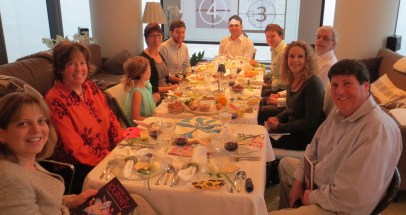How many times have I been told, “Funny, you don’t look like a rabbi!” Thirty-six years ago, when I was working as a hospital chaplain, that comment was often followed by, “You don’t even have a beard.” I would reply, “No, and I’m not circumcised, either.”
“Funny, You Don’t Look Like A Rabbi”, was the title of the program for the Annual Luncheon of the Jewish Women’s Foundation of Chicago on January 18, 2017. Actually, the full title was “Funny, You Don’t Look Like A Rabbi: Tales from The Sacred Calling: Four Decades of Women in the Rabbinate.” The special guest speakers were the book’s editors, Rabbi Alysa Mendelson Graf and Rabbi Rebecca Einstein Schorr, who carried on a conversation, talk-show style, sharing their personal stories and some of the stories from The Sacred Calling. I was invited to offer HaMotzi at the luncheon, as one of the contributors to the book, as the first female rabbi in Chicago, and as one of the small group who, twenty years ago, brain-stormed about the creation of the Jewish Women’s Foundation. As I listened to my brilliant and funny colleagues entertain and inform this group of well-heeled and well-dressed women at the Jewish Federation building downtown, I was so engaged in their stories that I forgot to take notes for this blog post. Their stories carried me back into some of my own.
Rabbi Ellen Dreyfus Shares Her Sacred Calling from CCAR on Vimeo.
Every woman in the rabbinate has her own stories – of stupid comments, of inappropriate questions, of being ridiculed, and of being ignored. We have all been at that meeting where we made a point or suggested an idea, and several minutes later a man said the same thing and was praised for his brilliance. We have all been in the receiving line where some jerk we don’t know thinks it’s okay to kiss us and say, “Gee, I’ve never kissed a rabbi before!” We have all been publicly addressed by only our first names while the male rabbis in the room have been called Rabbi LastName. Most of us have been underpaid and untrained in asking for the compensation we deserved. Those of us with children have gone through agonizing decisions of how to juggle motherhood and our careers, and no matter what the decision, we have been subjected to the criticism of those who think we could have/should have handled it better.
We also have our success stories and our moments of triumph. Those are usually not unique to us as women, but I don’t want to make it sound like our rabbinates are all war stories or tales of conflict and disappointment. There have been people who came to us for counseling because they felt more comfortable talking to a woman. There are those who thrived with a more collaborative style of leadership introduced by their female rabbi. We have had experiences in inter- and intra-faith dialogues with other women that were so much closer and easier than our male counterparts seemed to have.
As Rebecca and Alysa shared their narratives, answered questions, laughed together and delighted their audience, I looked around the room and realized that much of this was new to the women in attendance. Even though there have been women rabbis in Chicago for decades (I moved back here in 1983), and even though some of these women must belong to synagogues where women have served on the rabbinic staff, they were mostly ignorant of the obstacles we have faced and the attitudes that still plague our female colleagues. They had worked with Federation on paid family leave issues, so they resonated to Alysa’s reference to the challenge rabbis face when they give birth or adopt. It was encouraging to them and all of us to hear her frame it as a Jewish issue of supporting families and the Jewish future.
For me, personally, the event was very affirming. I was introduced with several of my “firsts” and was clearly the senior colleague of the many female rabbis present. The speakers kindly referred to me as one of the vatikot (veterans) of the first decade, and I looked upon them almost like a proud parent kvelling while her children succeed. A few days later, at the outdoor Shabbat service prior to the Women’s March on Chicago, one of the rabbis who organized the gathering asked me how it felt to see the next generation of women taking over. I told her how happy it made me to see that there are so many to continue the work I have been doing. It was one of those moments when I could actually see some of the fruits of my labors, and know that the Jewish future in Chicago is in good hands. And yes, she did look like a rabbi.
—
Rabbi Ellen Weinberg Dreyfus is Rabbi Emerita of B’nai Yehuda Beth Sholom in Homewood, Illinois. She is a past-president of the Central Conference of American Rabbis, and was the first woman to be president of the Chicago Board of Rabbis. She and her husband Jim have three grown children and four grandchildren. Her motto for the past several years is: “Grow where you’re planted.”







